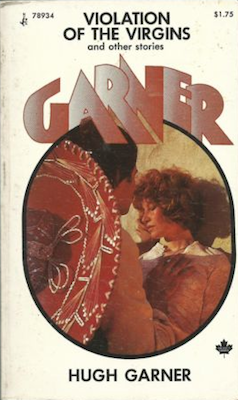So what's he doing writing a cheap paperback original?
The answer is going full circle and then some – past
Storm Below, his 1949 hardcover debut, to
Waste No Tears(1950),
Cabbagetown (1950)
and
Present Reckoning (1951). Paperback originals all, the latter three brought more money than would've been garnered – sorry – through higher literary endeavours. It's true that
Storm Below did the author well, but not in an immediate sense. A man needs to eat... and drink.
Garner's seventh novel,
The Sin Sniper landed just months after his sixth,
A Nice Place to Visit (1970). It enjoyed a higher print run, more editions, and as
Stone Cold Dead, would eventually be adapted for the screen in a film starring Richard Crenna, Paul Williams and Linda Sorensen.
Robert Fulford, who had a certain respect for Garner, was none too impressed. Writing in the
Ottawa Citizen (5 November 1971), he dismissed
The Sin Sniper as "close to being dreadful", adding "one was left with a nothing but baffling sense of being told to go left on Sumach, or right on Dundas, or left on Parliament."
I see what he means. This is the novel's opening paragraph:
Detective Inspector Walter McDurmont of the Metropolitan Toronto Police homicide squad jockeyed his three-year-old Galaxie along Dundas Street East in the morning rush-hour traffic. He crossed the Don River over the Dundas Street bridge, swung left down River Street, made a right turn at Shuter, and stopped when confronted with the raised stop-sign of the school crossing guard at Sumach Street, near Park Public School.
Lest you get lost, the book features a map that looks to have been ripped from a city directory.
Garner's setting is Toronto's Moss Park neighbourhood. The premise is found in the title: a sniper is murdering prostitutes. First to die is Claudia Grissom, whose snow-covered body is found early one morning near the corner of Shuter and Jarvis. Bernice Carnival is shot the next day (Dundas Street, one block from the Dainty Dot, just the other side of Church).
Those looking for a good mystery will be disappointed. There's little detective work here; McDurmont banks pretty much everything on catching the sniper in the act. While he comes to focus the investigation on three suspects, one of whom proves to be the sniper, nothing is provided that might justify the decision.
What saves
The Sin Sniper is that the characters driving and walking through the streets of Toronto, turning left and veering right, are real people moving between real places. I'm not suggesting that this is a
roman à clef, but I'm certain that Garner, a self-confessed alcoholic, drew heavily on the folks he met in drinking establishments, just as I'm certain that the drinking establishments in the novel would be recognizable to Torontonians of a certain age.
A Torotontonian of a certain age himself, Robert Fulford would know much better than I just how true the novel is to the people and places of Moss Park. I enjoyed the tour as much as the encounters. Fulford concludes his dismissal of
The Sin Sniper by writing that the only mystery about the book is that it was published. To me, the answer is obvious: Money. Pocket Books recognized this, as did Paperjacks with their reissue, as did the investors in
Stone Cold Dead.
Meanwhile, we're still awaiting the screen adaptation of
Storm Below.
Money.
Trivia: Set in 1965, the climax of the novel takes place the same day as the Mersey Mops (read: The Beatles) play Maple Leaf Gardens. Garner moves the concert from the summer to the winter.
 |
| Outside the Beatles' 19 August 1965 concert, Maple Leaf Gardens, Toronto. |
More trivia: Stone Cold Dead was written and directed by George Mendeluk, who would the next year take on Charles Templeton's
The Kidnapping of the President.
Object: I bought my copy for $3.95 this past February 23rd, the day after what would have been Garner's hundredth birthday. A first edition, it features this misleading notice:
Access: Well represented in our university libraries. Decent copies of the first edition are plentiful and begin at $6.00. The 1978 movie tie-in, as
Stone Cold Dead, is less common but just as cheap.


















































